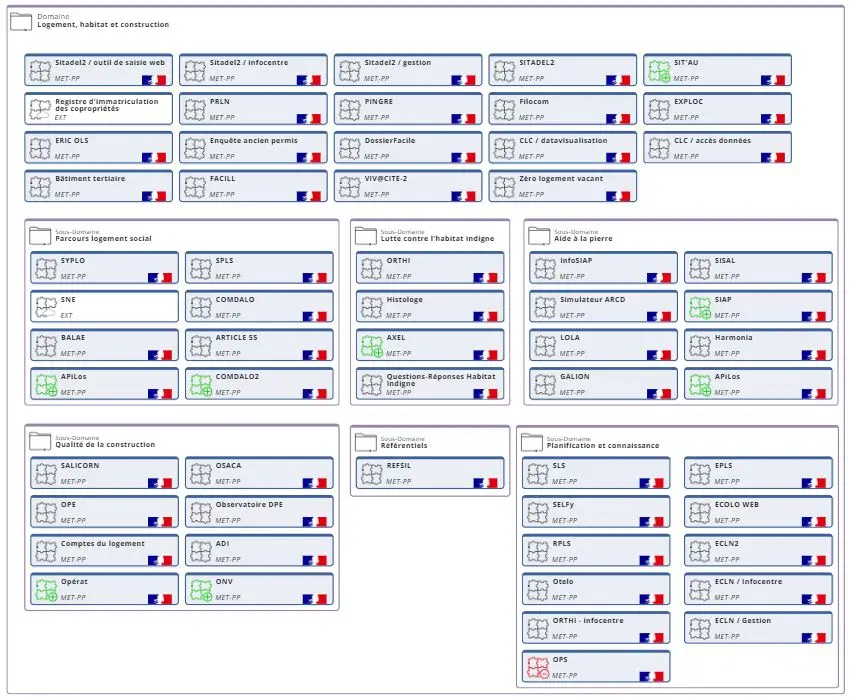Governance & Urbanization of the Information System – Ministerial Cluster
Case Study: French Ministries of Territories, Ecology, and Housing
About the Ministerial Cluster
- 37,000 employees
- 7 ministries (1)
- 9 General Directorates (2) / 3 Cross-Functional Structures (3) / Several hundred Territorial Services (4)
- A Digital Directorate (DNum) with 350 agents nationwide
- 1,500+ applications
Objective: Achieving a Comprehensive Understanding of the IS
Within the General Secretariat of the Ministries of Territories, Ecology, and Housing, the Digital Directorate (DNum) set a clear ambition:
Equipping the ministerial cluster with a governance tool based on a complete understanding of the Information System.
This is a major challenge given that 7 ministries and 35,000+ employees manage approximately 1,500 applications, which must be identified, documented, and mapped.
When the DNum launched the GUSI initiative (Governance and Urbanization of the Information System), they didn’t start from scratch.
Previous landmark projects, such as the Renoir RH program (the human resource management information system developed by the Interministerial Center for HR IT Services), had already outlined the IS landscape. However, this initial inventory was incomplete and faced maintenance and tooling challenges.
A Dedicated Architect to Lead the Initiative
Building on these early learnings, the DNum assigned a dedicated Enterprise Architect to lead the GUSI initiative. Reporting to the Digital Transformation Steering Department, their mission was to promote IT urbanization culture among DNum’s 350 agents and key stakeholders within the ministerial cluster.
One of their first major initiatives was implementing an IS mapping tool.
After a consultation and proof-of-concept phase, the chosen solution was myCarto.
“We needed a highly flexible approach given the diversity of organizations, practices, and expectations.
The tool’s simplicity, customization capabilities, and adaptable meta-model were decisive in choosing myCarto.”
Pierre-Louis CHAMELOT – IS Urbanization Advisor, DNum

The deployment strategy was based on a contributory and collaborative model—without mandatory participation.
Our approach is simple: we offer a service where everyone is both a contributor and a beneficiary. Participation is optional.
This decentralized dynamic relies on a dual-tool system: Wiki-SI and myCarto.
The wiki is used for knowledge documentation, while myCarto presents this information as interactive maps.
Pierre-Louis Chamelot – IS Urbanization Advisor, DNum
The GUSI initiative is structured around working groups that gather needs and share best practices. It brings together over 30 representatives from:
- The General Secretariat (centralizing cross-functional functions and steering ministerial reform strategies)
- General Directorates (business units within ministries)
- Decentralized services of the Ministries of Territories, Ecology, and Housing (regional and departmental services)
- Public institutions under the supervision of these ministries
"ON THE WAY" TIP
The implementation approach relies on Working Groups. In the initial phase, these groups gather and relay needs. During the usage phase, they provide support for adoption by sharing best practices. They are also responsible for prioritizing requests for system improvements.
Results & Benefits of the GUSI Initiative
While the GUSI initiative is inherently ongoing—given the continuous evolution of the ministerial cluster’s missions and IT system—the benefits of myCarto are already tangible:
- Faster onboarding of new employees, with an improved understanding of IS operations through clear system representations.
- Digital roadmaps benefit from a global vision, ensuring better alignment with strategic objectives.
- IT resources are more effectively allocated by identifying where to focus efforts.”Particularly in areas lacking digital services.”
- The General Inspectorate for the Environment and Sustainable Development (IGEDD) developed a functional IT map, which led to the creation of its 2023-2025 digital roadmap. This roadmap continues to evolve alongside ongoing initiatives.
- The General Directorate for Planning, Housing, and Nature (DGALN) conducted a comprehensive IS mapping exercise.
- This mapping was instrumental in defining the scope of a public tender, ensuring clear service expectations. The process remains ongoing, continuously refining and supporting contract execution.

"ON THE WAY" TIP
Once a year, instead of spring cleaning, it’s winter cleaning! All application managers update their records with the support of the Enterprise Architect, ensuring that IS data remains up to date year after year. Notably, by focusing on applications rather than software, the understanding and maintenance of the IS mapping have been significantly simplified.
La DNum dispose d’une connaissance de plus en plus précise et complète du parc permettant un meilleur suivi des projets et une gestion globale et transversale. L’analyse des flux de données associées aux applications RH est emblématique de cette transversalité. Les cartes de My Carto sur ces flux ont apporté un éclairage précieux.
Pierre-Louis CHAMELOT – IS Urbanization Advisor, DNum

Ministerial Cluster Structure
(1) Ministries in the Cluster :
- Ministry of Partnerships with Territories & Decentralization
- Ministry of Ecological Transition, Energy, Climate & Risk Prevention
- Ministry of Housing & Urban Renewal
- Ministry for Transport
- Ministry for Rural Development, Commerce & Craftsmanship
- Ministry for Maritime Affairs & Fisheries
- Ministry for Energy
(2) General Directorates
- DGAC – Directorate General for Civil Aviation
- DGEC – Directorate General for Energy & Climate
- DGALN – Directorate General for Planning, Housing & Nature
- DGCL – Directorate General for Local Authorities
- DGPR – Directorate General for Risk Prevention
- DGITM – Directorate General for Infrastructure, Transport & Mobility
- DGAMPA – Directorate General for Maritime Affairs, Fisheries & Aquaculture
- DIHAL – Delegation for Housing & Access to Housing
- IGAM – General Inspectorate for Maritime Affairs
(3) Cross-Functional Structures :
- SG – General Secretariat
- CGDD – General Commission for Sustainable Development
- CGEDD – General Council for Environment & Sustainable Development
(4) Territorial Services :
- DREAL – Regional Directorates for Equipment, Planning & Housing
- DIR – Interdepartmental Road Directorates
- DIRM – Interregional Maritime Directorates
- 98 Public Institutions under Ministerial Supervision
Learn more-Ministerial Cluster Website





